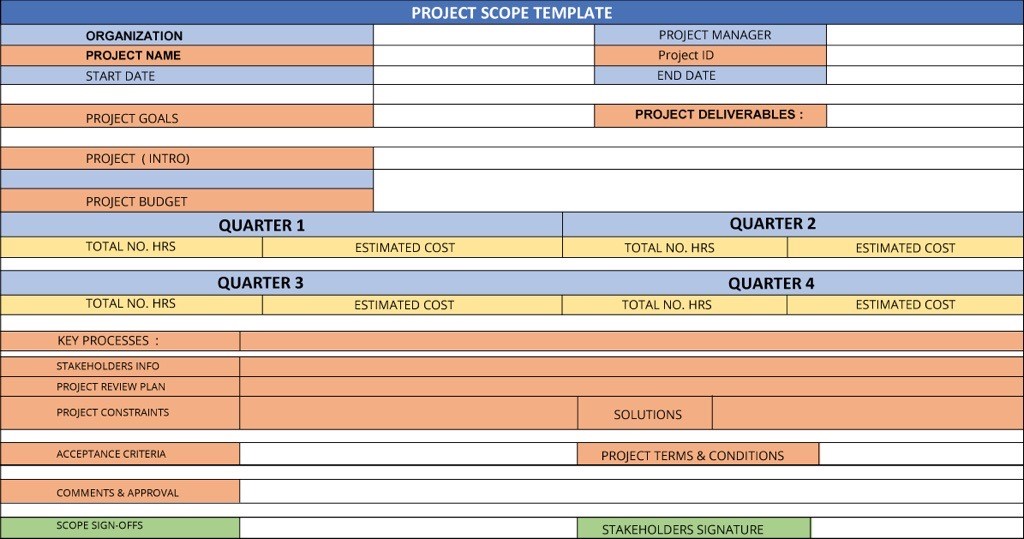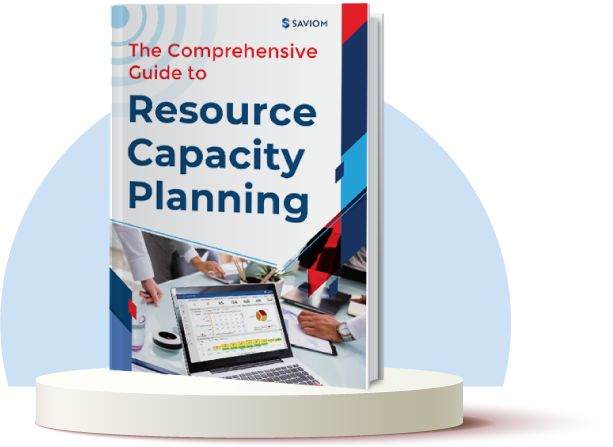Woody Williams once said, “Projects don’t fail at the end; they fail at the beginning.”
This statement highlights a fundamental truth in project management- successful delivery depends on how well a project is planned from the outset. The first step of this planning process is defining the project scope.
A well-defined scope sets clear goals, deliverables, and boundaries for the entire project. This clarity helps the project team and stakeholders to align their efforts and ensure successful delivery. Furthermore, a clear scope enables managers to effectively track progress against the baseline and address variances before they derail the project. Therefore, this structured process facilitates competent resource allocation and leads to seamless project execution.
In this comprehensive blog, we’ll delve deeper into the importance of defining project scope and the steps to create an effective scope statement.
But let’s first explore the basics.
What is Project Scope?
Project scope refers to the detailed outline of all the work required to complete a project successfully. It defines the project’s objectives, deliverables, tasks, deadlines, and constraints. A well-defined project scope serves as a foundation for planning, execution, and monitoring. It helps teams stay on track and meet their goals within the allocated time and budget.
Let’s learn more about what is a scope statement in the following section, explaining its definition:
What is a Project Scope Statement?
A project scope statement, or the statement of work (SOW), is a written document that is used as the basis for making project decisions down the line. It elaboratively outlines the critical components, like estimating the resources required, constraints, assumptions, exclusions, project plan, schedule, budget, and more.
Furthermore, the scope statement acts as a binding agreement for project stakeholders, managers, and teams. It offers them a meticulous and transparent overview of what the project intends to accomplish and strategies to effectively reach completion. In addition, it keeps everyone aligned with the vital details that can secure the project’s fate.
Having understood the project scope and its statement, let’s take a quick walk through the essential components that define the project’s success.
Essential Project Scope Components
A scope statement template can be different for each project based on organizational standards and the nature of the project. However, a few critical elements are standard for each of them. They are as follows:
Goals & Deliverables
The first and foremost component of the project scope statement involves creating clear, concise, and measurable goals that explicitly outline what the project will achieve. In addition to setting SMART goals, defining key deliverables is vital as it prevents scope creep, helps track progress, and ensures stakeholder alignment throughout the project lifecycle.
Read More: Project Initiation: Nine Effective Steps to Kick-off Projects the Right Way
Key Processes
In the scope document, key processes describe the critical practices and methods the project team intends to cover during its lifecycle. Each process can be different in terms of the input, tools, and skills required. So, clearly defining these processes leaves no room for ambiguity, ensuring a seamless workflow from project initiation to completion.
Acceptance Criteria
Acceptance criteria are included in the scope of a project to cover the customer’s exceptional demands or requests. For example, do they want any specific functionality to enhance the user experience? By filling in such details, managers can ensure that every step is executed correctly and that the final product encapsulates specific demands.
Project Exclusions
When it comes to project scope planning, understanding what is out of scope is as important as defining what is in scope. Hence, setting clear boundaries helps project managers prevent scope creep, manage stakeholders’ expectations effectively, and offer clear guidance on what the project team must focus on.
Constraints such as time, finances, scope, resources, etc., affect the project’s execution. Thus, it is essential to include them in the scope document. Additionally, having predefined project constraints helps the managers develop an actionable mitigation strategy upfront to handle any potential risks before they escalate.
Read More: Project Constraints: What are They, and How to Manage Them Effectively?
Assumptions
The project scope’s final component involves assumptions, which are the underlying beliefs or assertions considered to be true or certain but haven’t been fully verified. In project management, managers make initial assumptions to facilitate decision-making and planning. Doing so helps them avoid major misunderstandings and risks.
Now that we know all the components included in the project scope statement, let’s look at an example to understand it better.
Project Scope Example
Project scope in project management plays an integral role in determining its success or failure. Here’s an example of a construction project to demonstrate what’s included in the scope statement and how it’s created.
Project Scope Statement
A construction company is handling a project to construct a neighborhood park. To execute the project smoothly and without interruptions, the manager creates a detailed scope statement. They include all the key components playing a significant role in achieving the project goals successfully. Here’s how they developed a document:
| Project Name | Neighborhood Park Development Project |
|---|---|
| Description | Construction of a safe and accessible neighborhood park with recreational spaces for all age groups. |
| Deadline | 18 months from project start |
| Manager | (Project Manager’s Name) |
| Goal | Develop a community-friendly park with walking trails, playgrounds, picnic areas, and seating spaces to enhance well-being and social interaction. |
| Deliverables | – Paved walking trails – Children’s playground – Picnic tables and benches – Trash receptacles – Small community garden – Proper signage for park rules and safety |
| In-Scope Items | – Land preparation and construction – Installation of playground equipment and seating – Landscaping and planting native greenery – Setting up lighting and waste management solutions – Ensuring accessibility for people of all abilities |
| Exclusions | – Commercial spaces – Private event facilities – Large-scale parking areas – High-maintenance landscaping features |
| Constraints | – Must comply with local zoning laws and environmental regulations – Budget limitations (Total budget: $2,500,000) – Weather conditions may affect construction timelines – Community feedback implementation within feasibility limits |
| Stakeholder Buy-In | – Involvement of local government, community leaders, and residents through meetings and surveys – Regular updates via community forums and social media |
| Change Control Process | – Structured process to evaluate and approve modifications – Address additional feature requests or layout changes – Ensure transparency in budget and timeline adjustments |
So, now that we have a clear understanding of project scope, let’s learn the key benefits of it.
The Importance of Defining a Project Scope
Defining scope is a key element of project planning. It acts as a framework for the entire project team, specifying the objectives and tasks to be undertaken while clarifying the exclusions. As a result, it helps avoid confusion, prevent scope creep, and ensure alignment between the stakeholders’ expectations and the final deliverable.
Additionally, with a well-defined project scope, managers can ensure efficient resource allocation by assigning the right team members to the tasks with the necessary skills and competencies. Doing so helps meet deadlines on time and within budget, produce high-quality deliverables, and prevent over-and underutilization of resources.
Moreover, it precisely plays a crucial role in risk prevention by assessing potential challenges like resource constraints, skill gaps, etc., early in the project lifecycle. This allows project managers to implement proactive risk mitigation strategies like hiring or upskilling to ensure smooth and undisrupted workflow.
Furthermore, by accurately defining project boundaries, deliverables, and constraints, the scope statement establishes a solid foundation for change management. When unexpected changes arise, it serves as a reference point to assess their impact on timelines, budgets, resources, and objectives. This approach facilitates a seamless approval process, prevents cost overrun, and maintains the project’s momentum.
Read More: What is a Project Plan & How to Create an Effective One?
Having learned how beneficial a project scope statement is, let’s see how an effective project scope can be created.
Steps to Create an Effective Project Scope Statement
A scope statement is crucial to the organization and clients, so managers must meticulously follow specific steps to get it right. Here are the ways to create an effective scope document:
Identify Project’s Objectives & Define Scope
The first step in creating a scope statement involves identifying project goals and objectives. These objectives should follow the SMART criteria—Specific, Measurable, Achievable, Relevant, and Time-bound—to ensure clarity and feasibility. A well-defined objective provides a clear purpose for the project and helps stakeholders measure success at different stages.
Once the objectives are established, the next step is to define the project scope. The scope includes all the activities, tasks, and deliverables required to achieve the project goals. It is equally important to define what is out of scope to avoid misunderstandings and prevent unnecessary workload. By setting clear boundaries, teams can focus on the essential aspects of the project, ensuring that resources are allocated efficiently.
Read More: What is a Project Lifecycle? Phases, Importance & Best Practices
List Key Project Deliverables
The second step involves listing down the deliverables the project team needs to produce to meet defined objectives. This phase requires a detailed explanation of each deliverable’s characteristics, functionality, and alignment to pre-determined quality standards. Doing so not only guides the team and stakeholders toward a common vision but also facilitates stringent progress tracking.
During the planning stage, managers can engage with stakeholders to determine which deliverables best serve the project’s purpose. This collaborative approach ensures that the project meets the client’s needs and expectations while keeping the team focused on creating tangible outcomes that address key requirements. Moreover, listing deliverables and project milestones helps identify scope creep early, ensuring a smooth workflow.
Assess Major Project Constraints
The third step includes assessing constraints, which can bring a project to a grinding halt if not addressed appropriately. The top three constraints to managing a project include time, cost, and scope, known as the triple constraints. These constraints are interdependent, implying if there’s a change in scope, it leads to a domino effect, adversely impacting the timeline and budget.
However, some other constraints might crop up, including resource unavailability, project risks, technical limitations, and more. Hence, it’s critical to foresee and document constraints in order to develop mitigation strategies beforehand and prevent interruptions to the project work. Also, communicating these expected limitations to stakeholders is vital to making informed decisions.
Read More: Project Constraints: What are They, and How to Manage Them Effectively?
Develop Acceptance Criteria
The next step is establishing acceptance criteria, which are quantifiable and verifiable conditions that the project deliverables must meet to be accepted by stakeholders or clients. These criteria serve as the basis for assessing the deliverables’ quality standards, specifications, and requirements, supporting teams with clear guidelines to meet stakeholders’ expectations.
For instance, in a software development project, acceptance criteria include passing security testing, ensuring the application runs smoothly across different devices, and completing user acceptance testing (UAT). Therefore, it’s critical for project managers to ensure each deliverable within the scope must have clearly defined acceptance criteria.
Establish Scope Control Process
This step includes developing a structured control process to effectively manage changes to the scope baseline. Since the scope is the pillar of the project, any lack of clarity or misalignment with the overall objectives can result in scope creep, delays, or budget overruns. Hence, evaluating the performance against the baseline at every stage is vital to see whether the project is moving as expected.
This consistent monitoring allows managers to assess the magnitude of the variance and its impact when work deviates from the agreed scope. For this, they can identify necessary modifications and suggest a corrective action plan (CAP) to keep the scope under control. Such actions could include redefining the deliverables, revising the original plan, and adjusting the project budget, schedules, and allocations.
Read More: 7 Effective Strategies to Avoid Scope Creep in Project Management
Validate Scope with Stakeholders
After the scope control process is established, the next vital step includes validating the scope with the stakeholders. This process involves gathering stakeholders’ feedback, addressing concerns, and obtaining formal acceptance to ensure the deliverables meet the agreed-upon requirements.
For validation, stakeholders review the scope baseline, work performance data, and key project documents such as the requirements traceability matrix and lessons learned report. They also assess verified deliverables before providing final acceptance. Based on their evaluation, they may approve the deliverables, request changes, or update project documents to ensure alignment with the project’s objectives.
Distribute the Scope Statement to the Team
Once the stakeholders and organization have mutually signed off on the project scope statement, the last step is to share it with the team. Managers can leverage different communication methods to share the scope statement with everyone. Moreover, it’s important to ensure that the document is easily accessible to the team members and written in clear, concise language so there is no confusion later.
Furthermore, team meetings should be prioritized to review the scope and address any questions. Doing so helps everyone stay informed of what is expected from them and prevents misunderstandings. In addition, if there are new updates or changes, project managers must communicate them immediately to the team, ensuring smooth project execution.
Read More: Why Project Communication Skills are Important and How to Master Them?
Now, let’s understand the key checklist to follow for developing an effective and clear project scope statement.
Best Practices for Creating an Effective Project Scope Statement
Here’s a list of some best practices to help managers craft a clear and compelling project scope statement.
Enter Every Attribute of the Project Precisely
The purpose of a scope document is to minimize ambiguities and align the end result with the expectation. An unclear scope document may derail the project. Therefore, managers must try to be as specific as possible about every aspect of the project. Also, it’s important to keep the language consistent and clear and avoid using jargon.
Brainstorm Project Ideas with the Team
As a project manager, it is essential to brainstorm project ideas and take input and suggestions from the team, subject matter experts, and other senior officials before creating the scope statement. These invaluable insights help ensure accuracy in the scope and prepare to mitigate any potential project risks or challenges down the line.
Read More: 9 Effective Ways to Empower Cross-Functional Teams
Use Infographics for a Better Description
Using infographics in the scope statement assists managers in presenting complex information in visually appealing and consumable chunks. Elements such as charts, graphs, icons, symbols, and colors help keep the stakeholders engaged and informed about every critical project detail, facilitating information delivery faster.
Learn from Past Projects
When creating a scope statement, reviewing past projects or lesson-learned reports can help identify common challenges, successful strategies, and areas for improvement. It gives an overview of what worked well and what led to scope creep or delays. Therefore, managers can use these insights to refine the project scope for better outcomes.
Read More: 12 Key Project Reports for Successful Project Managers
Leverage the Project Scope Template
A scope document should contain several standard elements such as goals, milestones, deliverables, project schedule, etc. Using a standard template will save time and ensure that the documents are consistent and that nothing is left out. Also, various scope templates are available, depending on the nature of the business.
The following template entails the critical aspects of a project scope statement:

A Detailed Project Scope Template helps managers capture and organize the critical details and components of a project.
The Bottom Line
Whether you’re building a new product from scratch, going through a redesign, or just getting some illustration done, a scope statement can keep everyone accountable and maintain the project’s progress. The methods mentioned above will help managers create a well-defined scope document and provide a clear picture of the project. This will result in the successful completion of the project within the timeline and budget.
The Glossary
Read More: Glossary of Resource Workforce Planning, Scheduling and Management












